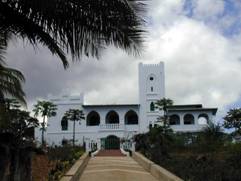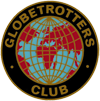Back in January 2004 Martin Wright, one the club’s most sociable regulars at the London Meetings, royally entertained a packed Crown Court with tales of his marathon cycle ride to Australia ! Many in that audience will remember his great photos, distinctive narrative style and his thirst for adventure. Well Martin is at it again – this time he’s go back to the land down under to ‘pick up his bike and have a look round’. I think too many cold winter nights provided the motivation to get back on the road ! Anyway this is the first in an occasional series, based on Martin’s emails, and charts his offbeat approach to the road ahead.
6 May 2004 : “Since arriving in Sydney a few weeks ago I have caught up with a few friends and been forced against my will to drink obscene amounts of alcohol. The cycling has been great apart from arriving and leaving any of the big cities. One time a passenger in a car leaned out of the window and pushed me off the road and of course swore at me. Luckily I was travelling slowly so came to no harm. After Canberra I cycled through the snowy mountains passing through Cooma, Jindabyne, Thredbo, over dead horse gap at 1590 metres above sea level, Geehi and Cooryong where I stayed much longer than intended due to there being a festival dedicated to one of Australia’s greatest poets, Banjo Patterson, and particularly his greatest poem, the man from snowy river. Lots of bush poetry was recited, lots of yarns were told, lots of music played. It was a great 3 days rest for me. I cycled on to Melbourne, which took me another 5 days where I caught up with Mark Attwood, another Pom who has left the mother country for better weather. Whilst here we watched Aussie Rules Football at the Telstra dome – Essendon v West Coast Eagles. Great game for a first timer !
Went to the theatre to see a play called, ‘ridiculousness’, which is summed up by its title. Found a pub which sold Guinness then found another pub which did not sell Guinness but had a very lovely barmaid from New Zealand who gave me a few free drinks… Leaving Melbourne I soon got lost only to find my way again, eventually made it to Manangatang where I caught up with the glass jar himself, Phil Matthews. Phil’s cooking has improved and his ability to drink is about the same. Mark Attwood came up for a few days and we visited Chinkapook, a place where I have a history concerning an aboriginal lady in 1984 ! Watched country football at Manangatang after which we drank beer, had a bbq, drank more beer then watched lucky Liverpool beat Man Utd ! What a bloody awful game. From Manangatang to Koorlong where I stayed with Phil’s brother Rob for a few days I spent a few days out at the farm trying to help put up a half kilometre of fencing – the fence looked good and my contribution was to hand out a few tools where needed and collect our lunch boxes ! From Koorlong to Kulwin to Paringa in South Australia to Morgan and on to Burra from where I am having yet another day of rest.”
24 May : “Hello from Ceduna. My bike is starting to get tired so I will have to stay in this god-forsaken town until it has been given a little T.L.C. Shouldn’t take too long ! If you all look at your maps of Australia which you obviously have open in front of you so you can follow my every move you will see Ceduna situated to the west of the Eyre Peninsula. From here over to Perth I will be crossing the Nullabor – I will also be cycling on the longest straight section of road in the world. I think it is about 140kms without even the slightest kink… take a photo to prove it.
The wind was a bastard most of the way around the Eyre Peninsula- it is harder than cycling uphill, as you never get a moments rest ! I met a couple of interesting-eccentric characters on the way round. The first was a travelling vacuum cleaner salesman and the second a Professor from the Sorbonne in Paris – he seemed to have a brilliant mind for most things but when I mentioned the F.A. CUP FINAL taking place in Cardiff on may 22nd he was totally bemused !”
14 June : “Hi all – Rex Hunt here or is it Greg Norman ? Still in sunny, windy & rainy Esperance and loving the rest. Went fishing the other day with the hostel owner and a Japanese chap. It was sunny windy and rainy but it did not stop us catching a few tiddlers. I myself caught three fish; my first ever, and a few were caught by the other two amateurs ! Back at the hostel I learned the art of scaling, gutting and filleting fish. It was then down to cooking and eating everything between us… I left the cooking to Katsuo (the Japanese fellow) I did the washing up but the fish was bloody brilliant.
Yesterday I joined a group of five others for a round of golf in the ‘ESPERANCE BACKPACKERS INVITATIONAL’ at the Pink Lake Golf Club. The criteria for being invited – you had to be bloody useless at golf ! We bought two crates of beer, hired two golf buggies then headed for hole number one. We managed five holes and ten beers each in three hours. For holes one to five my scoring was as follows : hole one par five – 17, hole two par five – 12, hole three par three – 5, hole four par four – 8 and hole five par four – 6. My favourite clubs were a five wood and a putter, with which I hardly ever got the ball off the ground as I zigzagged my way to every hole. The rain and the light put paid to completing the eighteen holes..
This morning I woke up with a headache so decided another rest day was needed… have been the bloody pizza I ate. Will move on from here tomorrow I think and should take about two weeks to reach Perth. I will expect to receive many e-mails – those of you who have not written I think it is about time you did… Enjoy ! PS – Bloody lucky French”
… map of Martin’s progress…
To contact Martin for a chat, a question or to discuss anything he’s talked about on his journey email him on eggodyssey@yahoo.co.uk. After all Martin & his travel adventures are what the club is about and it feels worth supporting him…
Report by:Matt Doughty
 Seeing the Boma, (see photo by the Beetle,) now a fully restored small hotel is even more amazing than any of the photos I had seen, such a dramatic transformation from the derelict building here on my arrival, which was only just nearing completion when I returned for the millennium festivities. It now stands in grounds surrounded by all manner of vibrant vegetation, attracting varied animal life – from butterflies to lizards to the occasional monkey.
Seeing the Boma, (see photo by the Beetle,) now a fully restored small hotel is even more amazing than any of the photos I had seen, such a dramatic transformation from the derelict building here on my arrival, which was only just nearing completion when I returned for the millennium festivities. It now stands in grounds surrounded by all manner of vibrant vegetation, attracting varied animal life – from butterflies to lizards to the occasional monkey.

 We are sorry to say that Mac is not very well, but he is still e-mailing strong and recently sent the Beetle a collection of Mac reminiscences about some of his travels around India in 1992.
We are sorry to say that Mac is not very well, but he is still e-mailing strong and recently sent the Beetle a collection of Mac reminiscences about some of his travels around India in 1992.